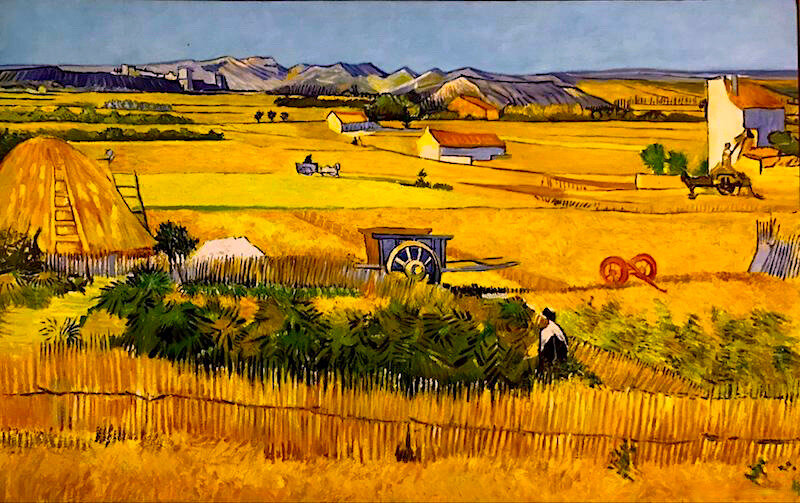Uropi: U komùn intranasioni linga 2 - Langue commune internationale - A common international language
* Uropi Nove 115* Uropi Nove 115 * Uropi Nove 115 *
Van Gogh, De mesad
★ ★ ★
4) Truvizid gon Intranasionid
* * * *
Un intranasioni eldilinga doʒ so de maj intranasioni mozli, wim i av ʒa dezen.
I men te je doʒ ne sto eni misincepad ov de sinad de vordi ‘intranasioni’ (je sin « intra nasione », da se intra lingas). Od di vizipunt, Mandorini se mol poj intranasioni par je kopàrt mol poje vorde ki alten an-Cini lingas (Vize de samp ki ‘televìz’ sube).
Un mozev, po mezo de intranasionid vordis, kreato u koefisiènt intranasionidi, po samp televìz i-43+ (de vord televìz vid finden in maj te 43 lingas); diànshì : i-1 (un find ja in nun alten linga). A da, un moz ajuto u koefisiènt semlidi: s-(-), wan vorde we av ne de som odvenad somiv a unaltem. Po samp: kopo: i-16 + s-6 (je se semli a It. comprare, Esp comprar… etc.). Franci ‘acheter’, begòn se mol poj intranasioni: i-1, s-2 ki It. accattare (bedigo, inlesto).
apel: i-33, It. mela i-6, Fr. pomme = i-4, Esp. manzana i-3, Indirani: seb, sev i-7, Turki alma i-8
banàn (od u Gineu linga) = i-31+, Esp plátano = i-1
tomàt (Azteki vord) = i-33+, It. pomodoro = i-9, Sr paradajz = i-3, Rum roșie = i-1
cokolad (Azteki vord) = i-44+
Un od de maj intranasioni vorde se Arabi: kafa (od Arabi qahwa < od un Etiopi provìns nomen Kava) = i-65+; un alten se Cini: tej in ji du dialekti forme: te’ = i-34+ id tca = i-29+.
Is Uropi se bazen su Indeuropan lingas, je se par da lingas av prodaven de grenes numar intranasioni vordis in mold, ne solem Latini id Greci, ba os Sanskriti, Persi… Engli, Franci, Espàni…
Ba un alten kritèr lezidi se truvizid we pomòz no incepo de sin un ankonen vordi od de sin ji elementis. Po samp lucitòr od luc + tor (u tor ki u luc); koeglim, de Franci vord phare av u limìten koefisiènt intranasionidi: i-7, obwàn lucitòr = i-14 (tramìd wen Cini dēngtă ‘lamp’ + ‘tor’). Un alten samp se soliflòr (sol + flor), da se u flor somi a sol = i-18.
Uzo di truvizi struad (po koseto vorde) det Uropi maj neri a Cini.(Vize de koseten vorde in Uropi id Cini sube).
★ ★ ★
Fotò Claude Poulain
★ ★ ★
Ba truvizid moz konflìto ki intranasionid: ka uscepo ?
De Franci vord piscine: i-11 sem avo u relativim bun koefisiènt intranasionidi, ba di se trugi: je sem repero a pice, picia (vz. Lat. piscis), obwàn je del ov u basin wo humane sniv. A de kritere truvizidi id intranasionidi, un doʒev ajuto u kritèr etimologic kotenidi.
In di kaz, Uropi av uscepen truvizid: snivia (de sta wo un sniv) = i-21. Paralelim, nu av kokia (de sta wo un kok), bania (de sta wo un nem u ban), vendia (de sta wo un vend), wim in Japoni: panya (panoria), nikuya (miasoria), yōgashiya (pekoria), hanaya (flororia), honya (biboria) … i.s.p.
Gonim po skol, de intranasioni vord se obvizi = i-45.
Po hospitàl, id ambulàns, de truvizid wen un moz findo in Doski, po samp: Krankenhaus id Krankenwagen (da se has patienis, vag patienis) se ne mozli in Uropi. Prim par patien se ne unisilabi wim krank o sjuk (in Swedi) is un dez patidom je sin te de dom se pati: un obesinid wen un find in Rusi (bol’nitsa = hospitàl < bol’noj = pati); patienidom sev os obesini: del je ov de has u patieni ? u dom rusunivadi ? u mediki centra ? Po so verim procizi, un doʒev dezo patieniceridom (u dom wo patiene vid ceren… ba je se mol tio longi). Sim un prigusì de Engli-Espàni vord hospitàl = i-25+ id ambulàns = i-31+, we se os mol intranasioni.
Pur un doʒ ne agono truvizid id intranasionid: lu se priʒe kopolni. Wan je esìst u verim intranasioni vord wim kafa, skol, televìz… i.s.p., nu ve obvigim nemo ja. Wan je ste nun intranasioni vord, o wan vorde se poj intranasioni, nu ve struo truvizi vorde (koseten vorde), ba da truvizi struade som se molvos intranasioni wim lucitòr (i.14), snivia (i-21), soliflòr (i-18)…
* * * *
4) Transparence contre Internationalité
* * * *
Une langue auxiliaire internationale (LAI) se doit d’être le plus internationale possible comme je l’ai déjà dit.
Il ne faut pas qu’il y ait un malentendu sur le sens du mot international (qui signifie « entre les nations », c’est à dire entre les langues). De ce point de vue, le mandarin est très peu international car il partage très peu de mots avec les autres langues non sinitiques.(Voir l’exemple de la ‘télévision’ ci-dessus)
On pourrait, pour mesurer l’internationalité des mots, créér un coefficient d’internationalité, par exemple: televìz: i-44+ (le mot televìz se retrouve dans plus de 44 L.); diànshì: i-1 (on ne le trouve que dans une seule L.). A cela, s’ajoute un coefficient de similitude: s (-), lorsque des mots qui n’ont pas la même origine se ressemblent. Par exemple: kopo = acheter: i-16 + s-6 (similitude avec it. comprare, esp comprar… etc.). Le français ‘acheter’, en revanche, est très peu international: i-1, s-2 avec it. accattare (emprunter, mendier).
★ ★ ★
★ ★ ★
Ur. apel = pomme: i-33, fr. pomme: i-4, it. mela: i-6, esp. manzana: i-3, indo-iranien: seb, sev i-7, turc alma i-8
banàn = banane (du guinéen): i-31+, esp. plátano: i-1
tomàt = tomate (mot aztèque): i-33+, it. pomodoro: i-9+, ser paradajz: i-3, roum roșie i-1
cokolad = chocolat (mot aztèque): i-44+
Un des mots les plus internationaux est arabe: kafa = café (< ar qahwa, du nom de la province éthiopienne de Kava): i-65+; un autre est chinois: tej = le thé, sous ses deux formes dialectales: te’: i-34+ et tchaï: i-29+.
Si l’Uropi se base sur les langues indo-européennes, c’est parce que celles-ci ont fourni le plus grand nombre de termes internationaux, non seulement le latin et le grec, mais aussi le sanskrit et le persan, l’anglais, le français, l’espagnol…
Un autre critère de facilité c’est la transparence qui permet de déduire la signification d’un mot inconnu du sens de ses éléments. Par exemple lucitòr de luc = lumière + tor = tour > ‘tour de lumière’ = phare; le mot phare a un coefficent d’internationalité réduit: i-7, alors que la construction lucitòr = i-14 (y compris le mandarin dēngtă = lampe + tour); autre exemple: soliflòr (sol = soleil + flor = fleur) = tournesol: i-18+.
C’est ce recours à la transparence (mots composés) qui rapproche l’Uropi du chinois: (Voir les mots composés en Uropi et en chinois ci-dessus).
La transparence peut entrer en conflit avec l’internationalité: que choisir ?
Le français ‘piscine’: i-11+ semble avoir un assez bon coefficient d’internationalité, mais ce mot est trompeur: il semble se référer aux poissons (lat. piscis, Ur pice > picia = vivier), alors qu’il s’agit d’un bassin où nagent les humains. Il faudrait rajouter aux critères d’internationalité et de transparence un critère de cohérence étymologique…
Ici l’Uropi opte pour la transparence: snivia (lieu où l’on nage < snivo = nager) = i-21. Parallèlement, nous avons: kokia = cuisine (lieu où l’on cuisine), bania = salle de bain (lieu où l’on prend son bain), vendia = magasin (lieu où l’on vend)… etc., comme en japonais: panya (boulangerie), nikuya (boucherie), yōgashiya (pâtisserie), hanaya (fleuriste), honya (librairie)…
★ ★ ★
★ ★ ★
En revanche, pour ‘l’école’, le mot international s’impose: skol = i-45.
Pour ‘hôpital’ et ‘ambulance’, la tranparence que l’on retrouve en allemand: Krankenhaus, Krankenwagen (maison des malades, voiture des malades) ne fonctionne pas en Uropi. D’abord parce que le nom ‘malade’: patien, n’est pas un monosyllabe comme krank ou sjuk en suédois; patidom serait ‘la maison malade’; ambigüité que l’on retrouve en russe: bol’nitsa (< bol’noi = malade); patienidom aussi est ambigu: la maison du malade? centre de convalescence? cabinet médical? dispensaire? Pour être précis, il nous faudrait au moins patieniceridom: maison où l’on soigne les malades… qui est beaucoup trop long.
On a donc préféré le mot anglo-espagnol: hospitàl: i-25+ et ambulàns: i-31+, mot également très international.
On ne doit pas, cependant opposer transparence et internationalité; elles sont plutôt complémentaires. Quand il existe un terme véritablement international, comme kafa, skol, televìz, telefòn, hotèl … etc., celui-ci s’impose. Quand il n’y a pas de mot international, ou que son internationalité est très réduite, on a alors recours à des constructions transparentes (composition). Cependant, ces termes transparents eux-mêmes sont souvent internationaux, comme le montrent lucitòr (i-14), snivia (i-21), soliflòr (i-18)…
* * * *
4) Transparency versus Internationality
* * * *
An international auxiliary language (IAL) should be as international as possible as I said before.
But I think there shouldn’t be any misunderstanding on the meaning of the word international: it means « between the nations », that is between the languages. From this point of view, Mandarin is very little international since it shares very few words with the other non sinitic languages. (See the example of ‘television’ above)
In order to measure the internationality of words, we could create an internationality coefficient, for example: televìz: i-44+ (the word televìz scan be found in over 44 langauges); diànshì: i-1 (can be found in only one language). We could also add a similarity coefficient: s(-), when words from different origins look alike. For example: kopo = to buy: i-16 + s-6 (similar to It. comprare, Sp comprar… etc.). The French word ‘acheter’, on the other hand, is very little international: i-1, s-2 with It. accattare (borrow, beg).
Ur. apel = apple: i-33, Fr. pomme: i-4, It. mela: i-6, Sp. manzana: i-3, Indo-Iranian: seb, sev i-7, Turkish alma i-8
banàn = banana (from a Guinean language): i-31+, Sp. plátano: i-1
tomàt = tomato (an Aztec word): i-33+, It. pomodoro: i-9+, Ser paradajz: i-3, Rum roșie i-1
cokolad = chocolate (an Aztec word): i-44+
★ ★ ★
De katedràl in Cartre, Francia
★ ★ ★
One of the most international words is Arabic: kafa = coffee (< Ar qahwa, from the name of the Ethiopian province of Kava): i-65+; another one is Chinese: tej = tea, in its two dialectal forms: te’: i-34+ and chay: i-29+.
If Uropi is based on Indo-European languages, it is because they have provided the largest number of international terms, not only from Latin and Greek, but also from Sanskrit and Persian, English, French, Spanish…
Another feature that makes languages easier is transparency which enables us to deduce the meaning of an unknown word from the meaning of its elements. For example lucitòr from luc = light + tor = tower > ‘light tower = lighthouse; the French word ‘phare’ has a limited internationality coefficent: i-7, whereas the compound lucitòr = i-14 (including Mandarin dēngtă = lamp + tower); another example: soliflòr (sol = sun + flor = flower) = sunflower: i-18+.
Resorting to transparency (compounds) makes Uropi closer to Chinese: (See above: Uropi and Chinese coumpounds ).
Transparency may clash with internationality: How can we chose ?
The French word ‘piscine’ (swimmin pool): i-11+ seems to have a fairly good internationality coefficient, but it is misleading: it seems to refer to fish (Lat. piscis, Ur pice > picia = fishpond), whereas it means a pool where humans swim. To the criteria of internationality and transparency could be added a criterion of etymological consistency…
Here Uropi has chosen transparency: snivia (the place where you swim < snivo = to swim) = i-21. Similarly, we have: kokia = kitchen (the place where you cook), bania = bathroom (the place where you have baths), vendia = shop (the place where you sell)… etc., as in Japanese: panya (bakery), nikuya (butcher’s shop), yōgashiya (pastry shop), hanaya (flower shop), honya (bookshop)f
On the other hand, for ‘school’, the international word is a must: skol = i-45.
For ‘hospital’ and ‘ambulance’, the tranparency that we can find in German: Krankenhaus, Krankenwagen (patient house, patient car) cannot work in Uropi. First because the noun ‘patient’: patien, is not a monosyllable like krank or sjuk in Swedish; patidom would be ‘the sick house’; an ambiguity that can be found in Russian: bol’nitsa (< bol’noi = ill, sick); patienidom would also be ambiguous: the patient’s house? recovery centre? surgery? dispensary? To be precise, we should at least say patieniceridom: a home where patients are treated… which is much too long.
Therefore we have chosen the Anglo-Spanish: hospitàl: i-25+ and ambulàns: i-31+, another word which is also very international.
However transparency and internationality should not be opposed; they are rather complementary. When there is a really international term, like kafa, skol, televìz, telefòn, hotèl … it will necessarily be chosen. When there is no international word, or when internationality is limited to a few languages, then we would rather resort to building transparent compounds. However, these transparent terms are often international themselves, as lucitòr (i-14), snivia (i-21), soliflòr (i-18) show.
★ ★ ★
★ ★ ★
5) Prijan suprize !
*****
Uropi av u karakteristik, andubim deben a ji formad od de komùn Indeuropan rode, id wen i find priʒe fantastic.
Nemem de samp de vordi ‘apin’
Je vidì formen od de Germàni id Slavi vorde: ape, Affe, abe, apa, aap, обезьяна ‘abiziana’, opice, opica…, tale odvenan versemim od de Proto-Germàni rod *apan, we dav in Uropi apin.
Ka bun suprìz wan un kogòn usfalim de vord po ‘apin’ in Fini* !
Je se apina, da se puntim de femin in Uropi: apin > apina, aksenten somim su de pri silàb a- in obe lingas.
* Po formo de Uropi vord, i avì ne ceken de Fini vord dafòr, daven te Fini se ne un Indeuropan linga (de Fini vord vidì versemim inlesten od Germàni); i kogonì ja solem jesta, nerim usfalim.
Di ve dicto mo u lesiòn !
Naturim, vifti linge ve dezo: « Boh, he av solem inlesten de vord od Fini! » Ba je sì ne de kaz. Parkà avev i inlesten un apsolen vord od Fini ? Naturim un ve voko ov usfàl, ov koinfàl…
Ba di sort bun suprìzi se ne rari in Uropi.
Nemem de vord ‘has’ we s’u micen rod intra de Romaniki vorde: casa, casă…, id de Germàni term: Haus, house, huis, hus…
id suprìz !, ‘has’ se pratikim de Hungàri vord: ‘ház’ (= has); de adjetìv hasi se jok mol neri a Hungàri ‘házi’, koruvokan a u has.
Je se os de kaz ki de vord ‘mata’, ki de rod mat- od PIE *méhatēr, we davì Rusi ‘mat’’, Latini mater, Doski Mutter, Gaeli mathair… id sim pro, a wen vidì ajuten de femu fendad -a.
Id indèt, je se puntim de Hindi vord mātā (we av de som odvenad).
Di dik ʒe bun te Uropi usklùz a priori nun linga, ba gonim, tec vige intra lingas, tec vige intra polke…(jakun moz apero u kam a de komùn struen): di se de duv sin ni motu « Kreato u vig intra polke ».
De vord ʒina (od PIE *gʷénhₐ) se un eglivèz intra Slavi žena, Greci gunê (moderni yineka, vz Engli ‘gynaecology’), Germàni kvinna (Swedi), kvinne (Norveji), Engli queen (= raja)… ba je se os de kurdi vord: jin (in Kurmanji = ʒina).
Di dik ʒe bun te Uropi se ne u samujad vordis nemen usfalim od mole lingas, ba de resultad u perfeti razoni id koteni prostàp.
★ ★ ★
Marais Poitevin, Francia
★ ★ ★
5) Surprise !
******
Ce que je trouve assez fascinant en Uropi, et c’est dû sans aucun doute à la formation de ses mots sur les racines indo-européennes communes, c’est lorsque l’on crée, par exemple, le mot ‘singe’ à partir des termes germaniques et slaves: ape, Affe, abe, apa, aap, обезьяна ‘abiziana’, opice, opica…tous probablement issus d’une racine proto-germanique: *apan, ce qui donne en Uropi: apin, et que l’on tombe ensuite, par hasard, sur le mot ‘singe’ en Finnois*: apina, c’est à dire exactement la guenon en Uropi, les deux termes accentués pareillement sur le a- de la première syllabe.
*Je n’avais pas cherché le mot finnois (probablement emprunté au germanique) auparavant, la langue n’étant pas indo-européenne, je l’ai rencontré hier pour la première fois.
Ça m’apprendra !
Bien sûr, les mauvaises langues diront: « Bah, il a simplement emprunté le mot au finnois ! » Mais ce n’était pas le cas. Pourquoi est-ce que j’aurais emprunté un seul terme isolé au finnois ? Bien sûr, on parlera de hasard, de coïncidence…
Mais ce genre de bonne surprise n’est pas rare en Uropi.
Prenons le mot ‘maison’: has qui est un mot métissé entre les termes romans: casa, casă…, et les mots germaniques: Haus, house, huis, hus…et surprise !, c’est pratiquement le mot hongrois: ‘ház’(= maison); l’adjectif hasi (de la maison) est encore plus proche du hongrois ‘házi’, de même sens.
C’est également le cas du mot ‘mata’ (la mère), formé sur la racine mat- du PIE *méhatēr (mère) qui a donné le russe ‘mat’’, le latin mater, l’allemand Mutter, l’irlandais mathair… etc, à laquelle on a rajouté la terminaison -a du féminin.
Mais en réalité, c’est aussi le mot hindi: mātā (qui a la même origine).
Cela montre bien que l’Uropi n’exclut a priori aucune langue, mais au contraire, tisse des liens entre les langues, tisse des liens entre les peuples…(chacun peut apporter sa pierre à l’édifice commun): tel est le sens profond de notre devise: « Créer un lien entre les peuples. »
Le mot ʒina (la femme, du PIE *gʷénhₐ) est un équilibre entre le slave žena, le grec gunê (en gr. moderne yineka, cf ‘gynécologue’), le germanique: kvinna (suédois), kvinne (norvégien) = femme, anglais queen = reine…, mais c’est également le mot kurde: jin (en Kurmanji = femme).
Ceci nous montre bien que l’Uropi n’est pas un ramassis de mots pris au hasard un peu partout dans de nombreuses langues, mais le résultat d’une démarche parfaitement rationnelle et cohérente.
★ ★ ★
★ ★ ★
5) What a nice surprise !
*****
There is one feature in Uropi, which is undoubtedly due to its being built from the common Indo-European roots, and which I find fantastic:
It is when you create, for example, the word for ‘monkey, ape’ from the Germanic and Slavic terms: ape, Affe, abe, apa, aap, обезьяна ‘abiziana’, opice, opica…, all of them probably stemming from a proto-germanic root: *apan, thus apin in Uropi.
What a lovely surprise, when, by sheer chance, you come across the Finnish word* for ‘monkey’: apina, that is precisely the Uropi word for female monkey: apina, both words being stressed on the first syllable: a-.
*I hadn’t looked up the Finnish word (probably borrowed from Germanic) in the dictionary before, Finnish not being Indo-European; I met it for the first time yesterday.
This will teach me a lessson !
Of course sharp tongues will say « Pooh, he simply borrowed the word from Finnish! » But this was not the case. Why should I borrow a single isolated word from Finnish ? People will speak of chance, coincidence…
But this kind of a pleasant surprise is not rare in Uropi.
Let’s take the word has (house) which is a blend of the Romance terms: casa, casă…, and Germanic words: Haus, house, huis, hus…Surprisingly enough, has is practically the Hungarian word for ‘house’: ‘ház’; the adjectives are even closer: Ur. hasi, Hu. ‘házi’, relating to the house.
This is also the case for the word ‘mata’ (mother), formed on the root mat- from PIE *méhatēr (mother) which gave Russian ‘mat’’, Latin mater, German Mutter, Irish mathair… etc, to which the feminine ending -a is added. But in fact, it is also precisely the Hindi word: mātā which has the same origin.
This shows us that Uropi does not a priori exclude any language, but on the contrary, sets up links between languages, between peoples, each one adding its own contribution: this is the real meaning of our motto: « Creating a link between the peoples. »
The word ʒina (woman, from PIE *gʷénhₐ) strikes a balance between Slavic žena, Greek gunê (modern Gr. yineka, cf ‘gynaecology’), Germanic: kvinna (Swedish), kvinne (Norwegian) = woman, English queen…, but it is also the Kurdish word: jin (in Kurmanji = woman).
This makes it quite clear that Uropi is not a jumble of words picked up at random from numerous languages, but the result of a perfectely rational and coherent process.
Partager cet article


/https%3A%2F%2Fprofilepics.canalblog.com%2Fprofilepics%2F2%2F7%2F277026.jpg)










/http%3A%2F%2Fstorage.canalblog.com%2F10%2F54%2F321345%2F128701535_o.jpg)
/http%3A%2F%2Fstorage.canalblog.com%2F07%2F27%2F321345%2F126713582_o.jpg)
/http%3A%2F%2Fstorage.canalblog.com%2F98%2F36%2F321345%2F122463985_o.jpg)
/http%3A%2F%2Fstorage.canalblog.com%2F11%2F73%2F321345%2F122010012_o.jpg)